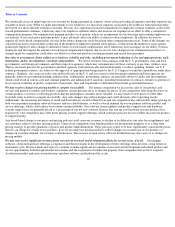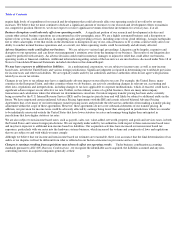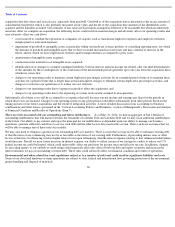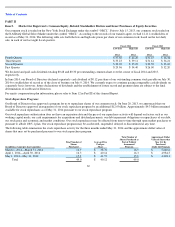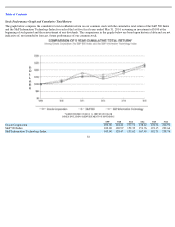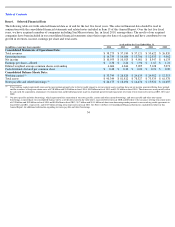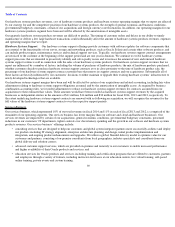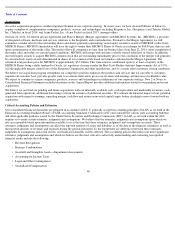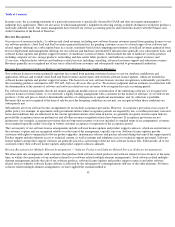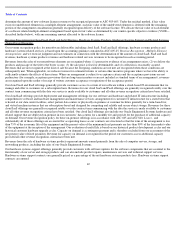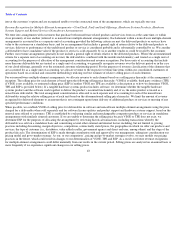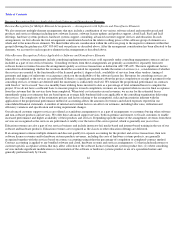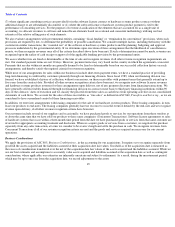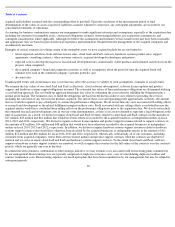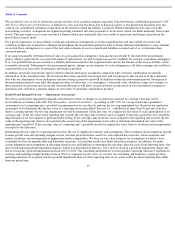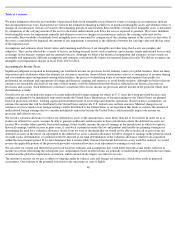Oracle 2013 Annual Report Download - page 42
Download and view the complete annual report
Please find page 42 of the 2013 Oracle annual report below. You can navigate through the pages in the report by either clicking on the pages listed below, or by using the keyword search tool below to find specific information within the annual report.
Table of Contents
percentage of revenues than our software and cloud business due to the incremental costs we incur to produce and distribute these products and
to provide support services, including direct materials and labor costs. We expect to make investments in research and development to improve
existing hardware products and services and to develop new hardware products and services.
Hardware Systems Products:
We provide a broad selection of hardware systems and related services including servers, storage, networking,
virtualization software, operating systems, and management software to support diverse IT environments, including cloud computing
environments. We engineer our hardware systems with virtualization and management capabilities to enable the rapid deployment and efficient
management of cloud and on-premise IT infrastructures. Our hardware products support many of the world’s largest cloud infrastructures,
including the Oracle Cloud.
Our hardware products and services are designed to work in customer environments that may include other Oracle or non-Oracle hardware or
software components. This flexible and open approach provides Oracle’s customers with a broad range of choices in deploying hardware
systems, which we believe is a priority for our customers. Our hardware products and services also help to meet customers’ demands to manage
growing amounts of data and business requirements to meet increasing compliance and regulatory demands and to reduce energy, space and
operational costs. We have also engineered our hardware systems products to create performance and operational cost advantages for customers
when our hardware and software products are combined as Oracle Engineered Systems.
We offer a wide range of server systems using our SPARC microprocessor. Our SPARC servers run the Oracle Solaris operating system and are
designed to be differentiated by their reliability, security, and scalability. Our mid-size and large servers are designed to offer greater
performance and lower total cost of ownership than mainframe systems for business critical applications, for customers having more
computationally intensive needs, and as platforms for building cloud computing IT environments. Our SPARC servers are also a core component
of the Oracle SuperCluster, one of our Oracle Engineered Systems.
We also offer enterprise x86 servers. These x86 servers are based on microprocessor platforms from Intel Corporation and are compatible with
Oracle Solaris, Oracle Linux, Microsoft Windows and other operating systems. Our x86 servers are also a core component of many of our Oracle
Engineered Systems including Oracle Exadata Database Machine, Oracle Exalogic Elastic Cloud, Oracle Exalytics In-Memory Machine and the
Oracle Big Data Appliance.
Our storage products are designed to securely manage, protect, archive and restore customers’ mission critical data assets and consist of tape,
disk, flash and hardware-related software including file systems software, back-up and archive software and storage management software and
networking for mainframe and open systems environments.
Our networking and data center fabric products, including Oracle Virtual Networking, and Oracle InfiniBand and Ethernet technologies, are used
with our server and storage products and are integrated into our management tools to help enterprise customers improve infrastructure
performance, reduce cost and complexity and simplify storage and server connectivity. We also offer hardware and software products and
services for communications networks including network signaling, policy control and subscriber data management solutions, and session border
control technology, amongst others.
The majority of our hardware systems products are sold through indirect channels, including independent distributors and value added resellers.
To produce our hardware products, we rely on both our internal manufacturing operations as well as third party manufacturing partners. Our
internal manufacturing operations consist primarily of materials procurement, assembly, testing and quality control of our Oracle Engineered
Systems and certain of our enterprise and data center servers and storage systems. For all other manufacturing, we generally rely on third party
manufacturing partners to produce our hardware related components and hardware products and we may involve our internal manufacturing
operations in the final assembly, testing and quality control processes for these components and products. We distribute most of our hardware
products either from our facilities or partner facilities. We strive to reduce costs by simplifying our manufacturing processes through increased
standardization of components across product types and a “build-to-order” manufacturing process in which products generally are built only
after customers have placed firm orders.
38


